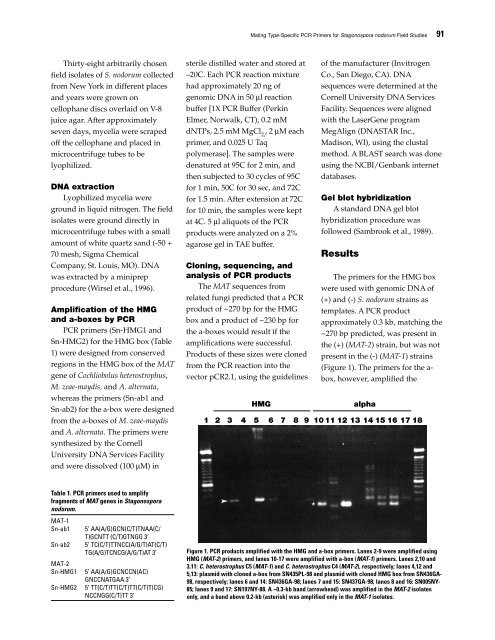Septoria and Stagonospora Diseases of Cereals - CIMMYT ...
Septoria and Stagonospora Diseases of Cereals - CIMMYT ...
Septoria and Stagonospora Diseases of Cereals - CIMMYT ...
Create successful ePaper yourself
Turn your PDF publications into a flip-book with our unique Google optimized e-Paper software.
Thirty-eight arbitrarily chosen<br />
field isolates <strong>of</strong> S. nodorum collected<br />
from New York in different places<br />
<strong>and</strong> years were grown on<br />
cellophane discs overlaid on V-8<br />
juice agar. After approximately<br />
seven days, mycelia were scraped<br />
<strong>of</strong>f the cellophane <strong>and</strong> placed in<br />
microcentrifuge tubes to be<br />
lyophilized.<br />
DNA extraction<br />
Lyophilized mycelia were<br />
ground in liquid nitrogen. The field<br />
isolates were ground directly in<br />
microcentrifuge tubes with a small<br />
amount <strong>of</strong> white quartz s<strong>and</strong> (-50 +<br />
70 mesh, Sigma Chemical<br />
Company, St. Louis, MO). DNA<br />
was extracted by a miniprep<br />
procedure (Wirsel et al., 1996).<br />
Amplification <strong>of</strong> the HMG<br />
<strong>and</strong> a-boxes by PCR<br />
PCR primers (Sn-HMG1 <strong>and</strong><br />
Sn-HMG2) for the HMG box (Table<br />
1) were designed from conserved<br />
regions in the HMG box <strong>of</strong> the MAT<br />
gene <strong>of</strong> Cochliobolus heterostrophus,<br />
M. zeae-maydis, <strong>and</strong> A. alternata,<br />
whereas the primers (Sn-ab1 <strong>and</strong><br />
Sn-ab2) for the a-box were designed<br />
from the a-boxes <strong>of</strong> M. zeae-maydis<br />
<strong>and</strong> A. alternata. The primers were<br />
synthesized by the Cornell<br />
University DNA Services Facility<br />
<strong>and</strong> were dissolved (100 µM) in<br />
Table 1. PCR primers used to amplify<br />
fragments <strong>of</strong> MAT genes in <strong>Stagonospora</strong><br />
nodorum.<br />
MAT-1<br />
Sn-ab1 5’ AA(A/G)GCN(C/T)TNAA(C/<br />
T)GCNTT (C/T)GTNGG 3’<br />
Sn-ab2 5’ TC(C/T)TTNCC(A/G/T)AT(C/T)<br />
TG(A/G)TCNCG(A/G/T)AT 3’<br />
MAT-2<br />
Sn-HMG1 5’ AA(A/G)GCNCCN(AC)<br />
GNCCNATGAA 3’<br />
Sn-HMG2 5’ TT(C/T)TT(C/T)TT(C/T)T(CG)<br />
NCCNGG(C/T)TT 3’<br />
sterile distilled water <strong>and</strong> stored at<br />
–20C. Each PCR reaction mixture<br />
had approximately 20 ng <strong>of</strong><br />
genomic DNA in 50 µl reaction<br />
buffer [1X PCR Buffer (Perkin<br />
Elmer, Norwalk, CT), 0.2 mM<br />
dNTPs, 2.5 mM MgCl2, , 2 µM each<br />
primer, <strong>and</strong> 0.025 U Taq<br />
polymerase]. The samples were<br />
denatured at 95C for 2 min, <strong>and</strong><br />
then subjected to 30 cycles <strong>of</strong> 95C<br />
for 1 min, 50C for 30 sec, <strong>and</strong> 72C<br />
for 1.5 min. After extension at 72C<br />
for 10 min, the samples were kept<br />
at 4C. 5 µl aliquots <strong>of</strong> the PCR<br />
products were analyzed on a 2%<br />
agarose gel in TAE buffer.<br />
Cloning, sequencing, <strong>and</strong><br />
analysis <strong>of</strong> PCR products<br />
The MAT sequences from<br />
related fungi predicted that a PCR<br />
product <strong>of</strong> ~270 bp for the HMG<br />
box <strong>and</strong> a product <strong>of</strong> ~230 bp for<br />
the a-boxes would result if the<br />
amplifications were successful.<br />
Products <strong>of</strong> these sizes were cloned<br />
from the PCR reaction into the<br />
vector pCR2.1, using the guidelines<br />
Mating Type-Specific PCR Primers for <strong>Stagonospora</strong> nodorum Field Studies 91<br />
<strong>of</strong> the manufacturer (Invitrogen<br />
Co., San Diego, CA). DNA<br />
sequences were determined at the<br />
Cornell University DNA Services<br />
Facility. Sequences were aligned<br />
with the LaserGene program<br />
MegAlign (DNASTAR Inc.,<br />
Madison, WI), using the clustal<br />
method. A BLAST search was done<br />
using the NCBI/Genbank internet<br />
databases.<br />
Gel blot hybridization<br />
A st<strong>and</strong>ard DNA gel blot<br />
hybridization procedure was<br />
followed (Sambrook et al., 1989).<br />
Results<br />
HMG alpha<br />
The primers for the HMG box<br />
were used with genomic DNA <strong>of</strong><br />
(+) <strong>and</strong> (-) S. nodorum strains as<br />
templates. A PCR product<br />
approximately 0.3 kb, matching the<br />
~270 bp predicted, was present in<br />
the (+) (MAT-2) strain, but was not<br />
present in the (-) (MAT-1) strains<br />
(Figure 1). The primers for the abox,<br />
however, amplified the<br />
1 2 3 4 5 6 7 8 9 101112131415161718<br />
Figure 1. PCR products amplified with the HMG <strong>and</strong> a-box primers. Lanes 2-9 were amplified using<br />
HMG (MAT-2) primers, <strong>and</strong> lanes 10-17 were amplified with a-box (MAT-1) primers. Lanes 2,10 <strong>and</strong><br />
3,11: C. heterostrophus C5 (MAT-1) <strong>and</strong> C. heterostrophus C4 (MAT-2), respectively; lanes 4,12 <strong>and</strong><br />
5,13: plasmid with cloned a-box from SN435PL-98 <strong>and</strong> plasmid with cloned HMG box from SN436GA-<br />
98, respectively; lanes 6 <strong>and</strong> 14: SN436GA-98; lanes 7 <strong>and</strong> 15: SN437GA-98; lanes 8 <strong>and</strong> 16: SN005NY-<br />
85; lanes 9 <strong>and</strong> 17: SN197NY-88. A ~0.3-kb b<strong>and</strong> (arrowhead) was amplified in the MAT-2 isolates<br />
only, <strong>and</strong> a b<strong>and</strong> above 0.2-kb (asterisk) was amplified only in the MAT-1 isolates.









